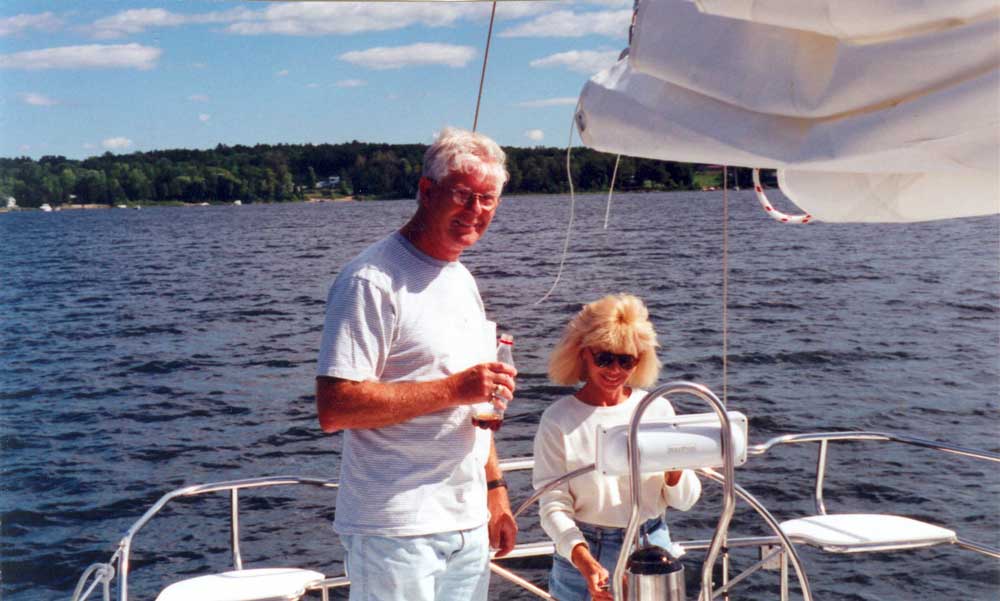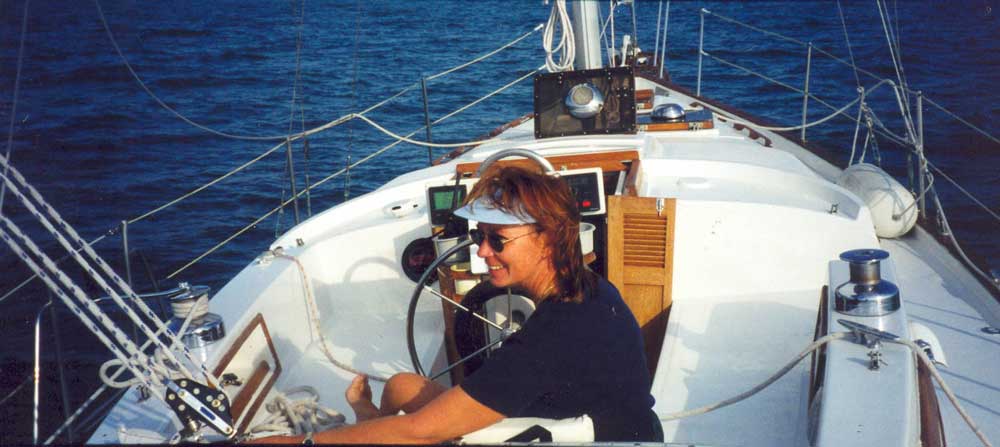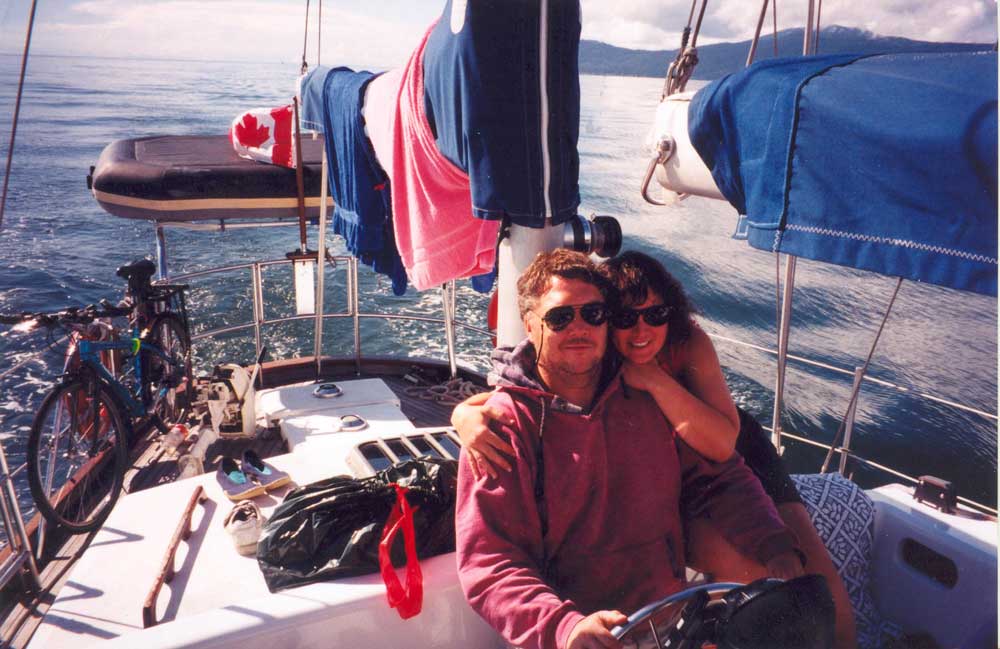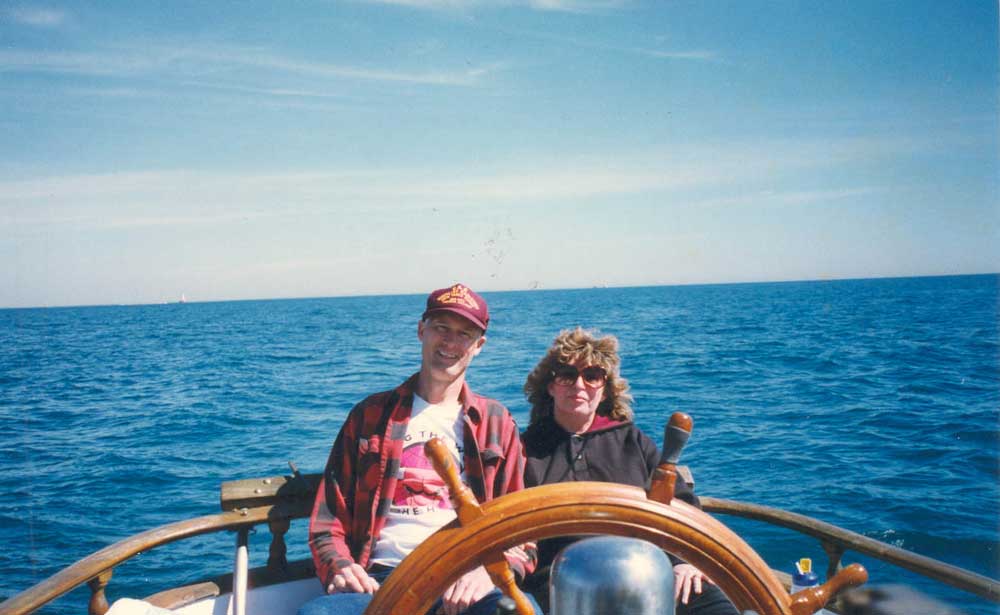Power Down & Sail
By Carolyn Corbett
“If the moon is a child’s nightlight, it should look the same from any boat. But it doesn’t. The world looks and feels different from a sailboat,” says Susan Trometer. “The first time I took the helm with the sails up, I felt like an ancient explorer, charting new land. The calm, the occasional squeak, the softness of the waves - it was serenity, unsurpassed.”
How does one decide between sail and power? Is it based on insight, instinct or
intellect? Or is it decided by the same mysterious force that causes one to
prefer chess to checkers, sirloins to T-bones, chocolate to vanilla, vodka tonic
to rum and coke?
 |
| Gus and Susan Trometer on their new 40-foot Chris Craft Sportsman. |
And why, one day, does a person change their mind? Is it mid-life crisis, a
sudden awakening, the booming voice of a higher power?
Stories abound of aging sailors who transition to “terminal trawlers.” More
power to ‘em, for they’re staying on the water. Yet a growing number of people,
including many in their retirement years, are taking up a new tack.
Susan Trometer and her husband Gus grew up with small boats in the Midwest. When
they moved to Lake Champlain in northern New York, they bought a 19 foot Cuddy
Cabin, then traded up to a 40-foot wooden Chris Craft Sportsman. They thought it
would be the perfect retirement/cruising boat.
Then they thought again. Maintenance was too costly, especially on a retirement
budget: 75 quarts per oil change, 3 MPG of fuel at 7 knots. Re-sanding,
re-caulking, repainting, and revarnishing, along with other routine maintenance,
fueled concerns. After being boat-less for a year on a lake dotted with
billowing sail, they began to think about a “boat under sail.”
For Susan, the decision to switch was simple. No more weekends spent working on
an old wooden boat that always looked like an old wooden boat. No more yelling
at the top of her lungs to be heard over rumbling diesels that gave a new
meaning to “screamin’ jimmies” back in the 1960’s. No more black smoke filling
the air at marinas causing sailors to think their boat was on fire. “Maybe we
only thought we were power boaters,” she says.
As for sailing, Gus thought, what’s the big deal? You put up the sails, aim them
into the wind, and go. If you don’t go, that’s what the engine is for. When they
bought their O’Day 31, heeling was a concern for Susan, as it is for many
newcomers. Two days of private lessons turned her into a “sailing animal,”
according to Gus.
Sailing was the shoe that fit, and as the cruising dream grew, so did the
longing for a larger boat. During the four years they owned the O’Day, the
Trometers were always looking for the perfect vessel. White Orchid, a
brand new Catalina MK II 34 arrived on the scene in 1997 ~ 5 quarts per oil
change, 14 MPG at 7 knots, no teak.
Cruising is no longer a dream. Gus and Susan moved aboard in 1998. That
September they pointed their bow south through the Champlain Canal and down the
Hudson River, headed for Norfolk and Mile 0 of the Intracoastal Waterway.
Perhaps the Trometers will cross wakes with Rich and Susan Davison. Rich and
Susan switched from a 23-foot Maximum to an Irwin 37 when they set up
boatkeeping together. The difference between power and sail? “We take our
sailboat out no matter the weather. No wind, fire up the iron horse. Too windy
for powerboats? Raise the sail.”
 |
| Susan Davison enjoying being a great yachtsmen. |
They use their sailboat hard, they say, while many powerboats in their area are
show pieces that never leave the dock. All their friends are power people,
though. They think Rich and Susan are great yachtsmen, because the thought of
sailing overwhelms them. “Little do they know,” Susan confides.
Last July, Rich and Susan retired from their jobs, tied the knot, untied the
lines and sailed up Lake Michigan, headed for the Erie Canal. When they reached
the Atlantic, they took a right. When Rita and Pierre Marchildon married, they
wanted to have ‘their’ boat. The 24-foot Bayliner they spent their honeymoon
aboard was getting expensive. They wanted a boat where they could raise children
comfortably. Long term plans include cruising for an extended period. All this,
they believe, is best done on a sailboat. Neither had sailed before. They are
learning on their home waters in British Columbia, where they go out every
weekend unless they have boat repairs, unavoidable commitments, or it’s
Christmas.
Rita and Pierre’s boating buddies were supportive when they bought their 45-foot
ketch. Reactions ranged from those who were curious to envious folks wanting to
live their dreams vicariously.
 |
| Rita and Pierre Marchildon on ‘their’ boat. |
But Alan and Bonnie Monfils’ friends coughed, choked and wondered if they had
bumped their heads on the dock. Why on earth would two powerboat fanatics buy a
41-foot pilothouse ketch? There was a brand-new boat with a Bravo 454 engine in
the Monfils’ driveway that they could ski behind!
Back when the kids were little, Alan talked of sailing away someday. Bonnie
couldn’t imagine it. It didn’t seem practical or affordable, so the idea was
shelved. Years passed, the kids grew up and Alan started planning for retirement
in his home state of Wisconsin.
Bonnie, dreading the long cold winters, asked Alan if he ever still thought
about sailing off into the sunset. Their 23-foot powerboat wasn’t the ticket.
Armed with the logic that they couldn’t afford a powerboat large enough for long
distance cruising, and that fuel prices would be prohibitive, Bonnie suggested
an alternative. They could probably find a sizeable sailboat at a reasonable
price.
Pandora’s Box burst open. They loved the outdoors. They had some sailing
experience crewing for friends. They needed a change in their lives. They didn’t
have to fit into any mold. They’d had a great time bareboating in the Bahamas
years ago. They wouldn’t need their house in the Chicago suburb with all its
expenses. They were on a roll.
 |
| Bonnie and Alan Monfils on their 1973 CT-41. |
The idea took on momentum and it was Southbound and throttle down. Alan raced
out to buy sailing magazines. Less than a week later, Bonnie spotted a 1973
CT-41 advertised in the newspaper.
It was larger than any boat they’d ever imagined owning. They’d never imagined
owning any boat large enough to have portholes. It was older than Al ever
considered, had more teak than he’d ever wanted to own. Bonnie loved the wooden
boat. It took two weeks to convince Alan. The two still aren’t sure it is
practical or affordable but.... “Do we sound like sailors?” asked Bonnie. “We
are now!”
Jim and Darleen Jackson described themselves as situational boaters. They select
the best craft for the boating situation, whether it’s a canoe on the Current
River, a ski boat on Lake Springfield, a houseboat on Kentucky Lake or a
chartered sailboat in the British Virgin Islands.
Early retirement is coming up next year, along with a move from Illinois to a
waterfront lot on the Neuse River in North Carolina. The Jacksons are walking
docks, “kicking the hulls” of sailboats. Maybe something in the 30-foot range,
with make and model determined once they have local experience. A boat in good
condition, so they can spend their time boating, not refitting or rebuilding.
They have realistic expectations from chartering and other previous experiences.
Jim anticipates a change in maintenance. Not an increase or a decrease, just a
difference. “Two things about power boating that we will not miss,” says Jim,
“are the engine noise and fuel bills.”
In what they call a Midwest cruising dilemma, the Jacksons currently trailer
their 26-foot Rinker Aft Cabin sixty miles to the nearest cruising area, rather
than be confined to one local lake. They look forward to the longer boating
season on the East Coast, along with the opportunity to drop everything to go
sailing when the weather is right. A runabout or fishing boat will be available
for trailering to other areas.
Jim and Darleen don’t understand folks who are “hung up” on power vs. sail. Any
invitation to join friends with powerboats or friends who sail is readily
accepted. It isn’t the height of the mast or the pitch of the prop that matters
to them. It’s the contents of the cooler and the congeniality of the company.
Yet, given a situation with no critical advantages to power, they prefer
sailing. Why? The quiet, the power of the wind, the feeling of self-reliance.
“There is nothing quite like raising the sails and letting the wind take you,
with nothing but the sound of water,” says Gus Trometer. “When I was a power
boater, I used to look at ‘those people’ going so slow, or maybe not going at
all. I guess you have to sail to know what sailing is. We won’t go back. We’ll
sail until we cannot anymore, then live on land and remember how much fun we
had.”
Carolyn Corbett is a freelance writer from Brainerd, MN.